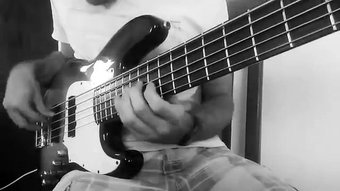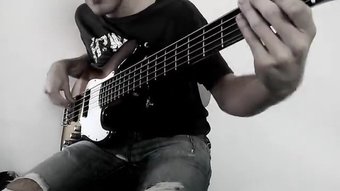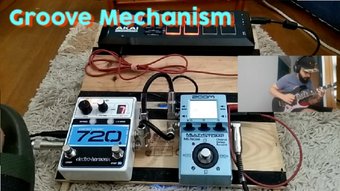[EN/ES] How do I think when improvising? How do I analyze harmony in jazz to improvise? (Intermission) / Como pienso a la hora de improvisar? Como analizo la armonía en el jazz para improvisar?(Intermedio)
7
About :
ENGLISH:
How do I think when improvising? How do I analyze harmony in jazz to improvise? (Intermission)
It is a fairly extensive subject but very interesting, since each musician can see improvisation in a different way, I personally got a method through the years of studies to see harmony from a central point, that is, in a way general, which will allow me to practice licks and phrases with much more meaning and which will also be applicable to any key.
It is true that each phrase or lick that sounds in my head, I take it to the instrument and in the instrument I apply them for all tones, for this we must know the modes and see what form that lick or phrase has, but as the modes always they belong to a tonality, so that's where we are already seeing it in a general way.
Example: I came up with a melody with the following notes, DAFB, here we are clearly seeing a Doric pattern on Dm, which would indicate that the key could be Cmaj, so simple: those notes mentioned above can be applied on any chord that forms naturally in the key of Cmaj, it is not necessary to wait for the Dm so that we can use that melody. This is where we begin to see harmony from a central axis (Tonal).
This is also applicable in progressions containing modal exchanges denoting indirect modulations
In the case of jazz you can see a lot, but it is the same principle, on any tonality that this moment phrases can be used regardless of the modal skeleton that they can draw.
Example: Let's analyze this progression, Am - D7-Dm-G7-Gm-Cmaj. It is a fairly simple progression, II-v II-v i-i, which we could think of in the following segmented way Am - D7 (Gmaj) -Dm-G7 (Cmaj) -Gm (Fmaj) -Cmaj (Cmaj)
What is between () are the keys in which we must think of those segments that mostly contain two chords, applying within those progressions any lick or phrase that we have within our language adapted to that key () or in the modes of the same .. simple.
In another post I will be talking a little more about this, and how to analyze more complex harmonies like John Coltrane's, and how to understand the art of outside notes, available tensions, how and when to use them.
ESPAÑOL:
Es una tema bastante extenso pero muy interesante, ya que cada músico puede ver la improvisación de una manera diferente, yo en lo personal conseguí un método a través de los años de estudios de ver la armonía desde un punto central, es decir de una forma general, que me permitirá hacer mi práctica de licks y frases con mucho más sentido y que además será aplicable para cualquier tonalidad.
Es cierto que cada frase o lick que suena en mi cabeza, yo la llevo al instrumento y en el instrumentos las aplico para todas las tonalidades, para esto debemos conocer los modos y ver que forma tiene ese lick o frase, pero como los modos siempre pertecen a una tonalidad, entonces ahí es donde ya lo estamos viendo de una forma general.
Ejemplo: Se me ocurrió una melodía con las siguientes notas, D-A-F-B, aquí claramente estamos viendo un patrón dórico sobre Dm, lo cual indicaría que la tonalidad podría ser Cmaj, entonces siemple: esas notas antes mencionada pueden aplicarse sobre cualquier acorde que se forme naturalmente en la tonalidad de Cmaj, no es necesario esperar el Dm para que podamos usar esa melodía. Es así donde comenzamos a ver la armonía desde un eje central(Tonal).
Esto también es aplicable en progresiones que contengan intercambio modales que denoten modulaciones indirectas
En el caso del jazz se ve mucho, pero es el mismo principio, sobre cualquier tonalidad que este de momento se podrán usar frases sin importar el esqueleto modal que puedan dibujar.
Ejemplo: Analicemos esta progresión, Am - D7-Dm-G7-Gm-Cmaj. Es una progresión bastante simple, II-v II-v i-i, que podríamos pensar de la siguiente manera segmentada
Am - D7(Gmaj)-Dm-G7(Cmaj)-Gm(Fmaj)-Cmaj(Cmaj)
Lo que está entre () son las tonalidades en que debemos pensar esos segmentos que contienen en su mayoría dos acordes, aplicando dentro de esas progresion cualquier lick o frase que tengamos dentro de nuestro lenguaje adaptada a esa tonalidad () o en los modos de la misma.. simple.
En otro post estaré hablando un poco más de esto, y de como analizar armonías mas complejas como la de John Coltrane, y como entender el arte de las notas outside, tensiones disponibles, como y cuando usarlas.
All content is my authority / Todo el contenido es de mi autoridad.
The chords or melodies used in the content may be my property or the original author / Los acordes o melodías utilizados en el contenido pueden ser de mi propiedad o del autor original.
Thanks to @OCDB from the @OCD team, @usainvote @kpine @anggreklestari @OCD @threespeak @appreciator @theycallmedan @cervantes @curangel @hive-193816 for your great support.
God Bless You!!!
Gracias a @OCDB del equipo de @OCD, a @theycallmedan @threespeak ,@anggreklestari @OCD @appreciator @theycallmedan @cervantes @curangel @hive-193816 @usainvote y @kpine por su gran apoyo.
Dios les Bendice!!!
Tags :
Their limit for today is $0!
More Videos
@kpine: 0.9070
@steemed-proxy: 0.4405
@curie: 0.4057
@music-community: 0.2195
@condeas: 0.1245
@shaka: 0.1204
@sherisworld: 0.0791
@postpromoter: 0.0745



























Comments:
Reply:
To comment on this video please connect a HIVE account to your profile: Connect HIVE Account